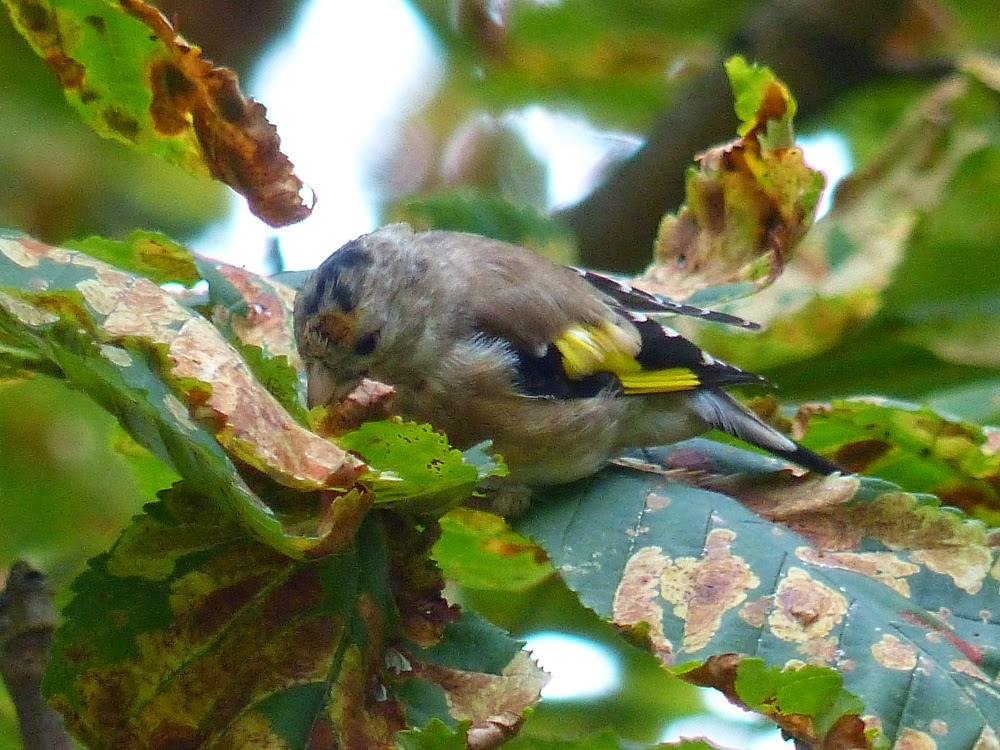The family of four Jackdaws flew over the Vista and stopped for a moment on one of the chestnut trees used by the Little Owls. One of them flew right into the tree and perched barely ten feet from the male owl.
But, just as happened yesterday with the Jay, it acted as if it had not noticed the owl, and flew out again without anything happening. Perhaps these medium-sized corvids, which would certainly attack any owl if they were in a group, are not so brave on their own and decide that discretion is the better part of valour.
The owl certainly did notice the intrusion, and when the Jackdaw had gone he shifted to a different branch. He looks annoyed -- but then, Little Owls always look annoyed.
Not far away, a Jay was waiting to come down for a peanut. Here it jumps from one branch to another to have a better launching point for its swoop.
The male Tawny Owl was in his favourite place on the broken trunk of the horse chestnut tree where they have their nest.
There was a small flock of Goldfinches in a nearby horse chestnut. This is a young bird just beginning to grow the red feathers on its head.
You can see the damage done to the leaves by the larvae of the leaf miner moth, which has affected all the horse chestnuts in the park. The Goldfinch was poking vigorously at the surface of the leaves, apparently to extract the insects -- though you would have thought that the moths had grown up and left the leaves by now.
The Great Crested Grebes at the wire basket near the bridge were alternately feeding their chick and fighting their neighbours. Here the mother is bringing the chick a small perch, identifiable by the spines on its dorsal fin.
The water level in the Round Pond, which had been so high that it was slopping over the edge when there was a wind, has been allowed to fall two inches. This makes the concrete platform at the edge a perfect bathing place for Starlings.
However, the new arrangement of the pond edge is not good for Pied Wagtails. They used to run along the old sloping edge picking up insects, but now almost all the edge is under water, except in a few places where the workmen got the level wrong.







Do you think that there are generally more Goldfinches in central London? These past few months I've been a delighted host to a small flock of them at my 4th floor window birdfeeder. (previous- and continuing- diners are Blue Tits, Great Tits and Greenfinches)
ReplyDeleteYes, lots of small birds are extra abundant after a mild winter last year.
DeleteI've also noticed an unusually high number of goldfinches for the time of year near some horse chestnuts I have long visited in north London. Seeing the picture above, I wonder if that food has something to do with it, especially considering that goldfinches can use one foot to grasp what they are pecking at? I had even started asking people, are goldfinches the new house sparrows? According to Wikipedia, this moth survives the winter via pupae that fall attached to leaves, so as long as the latter are still on the tree they should still be present.
DeleteI also wonder if we'll ever see the likes of early 2011 again when 'waxwings were the new starlings'. Jim n.L.
Thanks for information about the leaf miner's life cycle. Infestation is much less severe on trees where the grass is mown underneath, and this is obvious in the park.
DeleteI'm still waiting and hoping for sparrows to return; sometimes I think there is a bit of an increase not too far out of the centre. This may be wishful thinking.(I remember your description of the abundance of them in your young days)
ReplyDeleteThere are sparrows in north Kensington, north of the Westway. Haven't seen any farther in yet, but also hoping.
DeleteI have just heard (not seen) some at Freightliners City Farm in Islington; hope it's not just a fluke. My Goldfinches seemed to have been put of by the noise and vibrations of nearby building work- not for good one hopes.
DeleteYour mention of the pied wagtails at the Round Pond reminded me of a baffling incident I witnessed before the works and wonder if you can throw any light on it. A black-headed gull suddenly took to the air pursued closely by a pied wagtail, so close it could almost touch it. The disparity in size was even more pronounced in the air and I was baffled but impressed by the audacity of the tiny wagtail and the submissiveness of the relatively huge gull. So much so that I followed the wagtail to the other side of the pond where it landed (following your advice to keep my distance to avoid alerting what is normally a nervous bird) to see if I could get a clue as to what had happened. But it reverted to type, scurrying along the edge, paying little heed to a Mallard and an Egyptian Goose that were in its way but giving a very wide berth to a black-headed gull. Any idea why a pied wagtail might chase a gull and why the gull would allow it?
ReplyDeleteRemarkable. All I can suggest is that the Black-Headed Gull had seized some some creature the Pied Wagtail was about to take, and the wagtail had an attack of pond rage.
DeletePond rage. Brilliant!
ReplyDelete